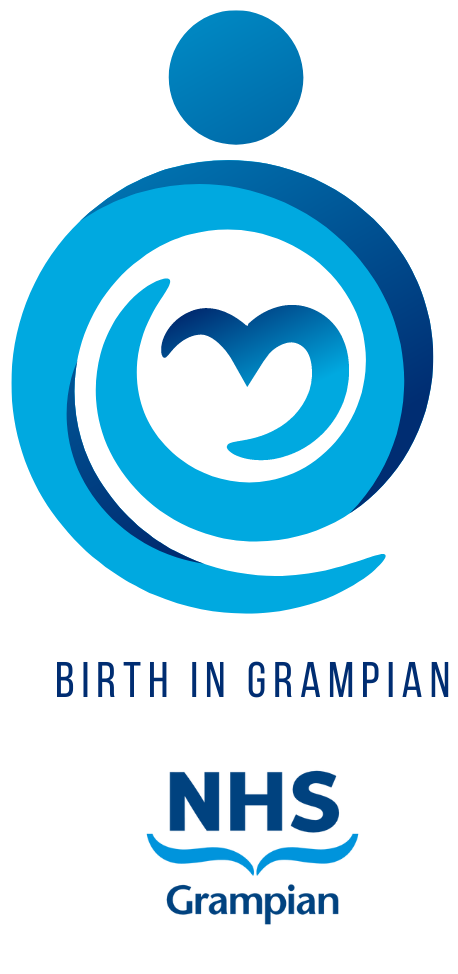
Labour ‘pain’ comes mainly from the stretching of the muscles of the uterus (womb) and cervix (neck of the womb) and is experienced differently by everyone. When in labour your body produces natural painkillers called endorphins. To help you adapt to the extra demands of carrying a baby endorphin levels rise as pregnancy progresses, and even more during labour. These endorphins act in three ways:
- They reduce physical pain.
- They create a sense of well-being.
- They have a memory-loss effect.
This helps explain why many women cope well with labour and birth yet often remember little of the pain afterwards. Some women do not describe their labour as painful at all and instead describe the contractions as just very intense. Labour pain and contractions may also change in sensation, frequency and duration throughout labour and each individual will experience and cope with pain differently, so you may consider trying a variety of different methods to help you throughout your labour. It can therefore be helpful to know what pain relief options are available to you before you go into labour. It can also be helpful for whoever is going to be with you during your labour to know about the different options, as well as how they can support you. You may also find it helpful to:
- talk to your midwife about what pain relief will be available to you, so you can decide what’s best for you.
- write down your wishes in your birth plan.
- learn as much as you can about labour – you could try talking to your midwife and going to some antenatal classes.
- keep moving and try different positions during labour.
- arrange to have a birth partner who can support you, if you can.
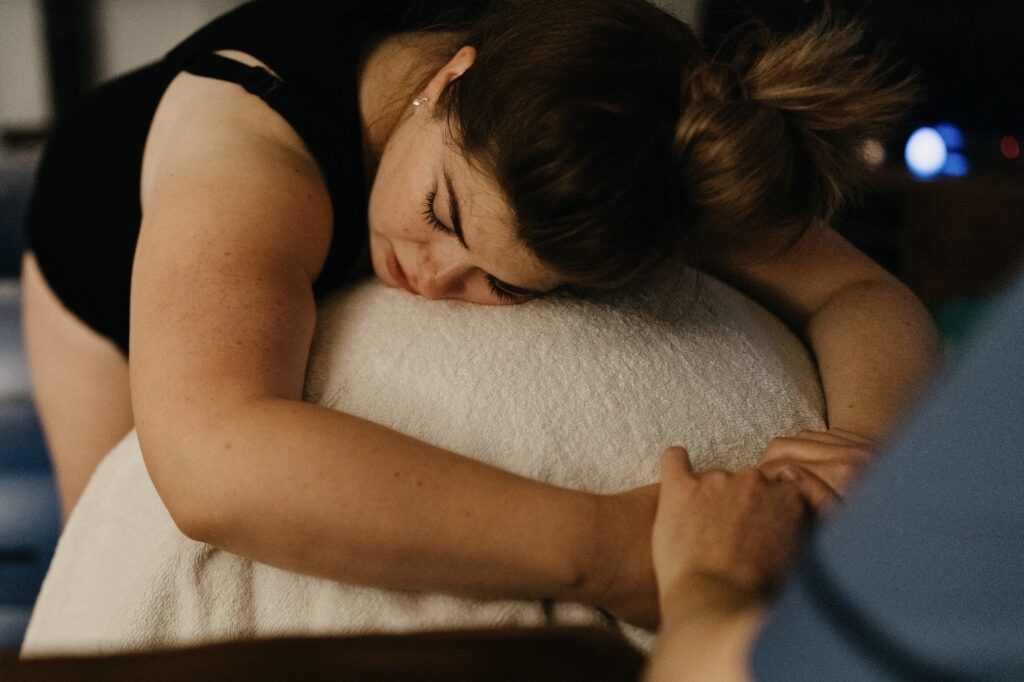
Breathing and Relaxation Techniques
Birth is as much a physiological process as it is a physical process. Breathing and relaxation techniques can help you cope with the intensity of the contractions and keep you calm and relaxed. Slow rhythmic breathing can help you get into a more relaxed state. You will find that you cope less well when you’re tense and anxious. When you are relaxed, your body releases its own hormone-like pain relievers called endorphins and these help you to copy better.
You can use breathing techniques whilst also using other pain relief options.
TENS (Transcutaneous Electrical Nerve Stimulation) Machines
A TENS machine sends mild, painless electrical pulses to your body when you’re having contractions, via sticky electrode pads attached to your back. Many women find this can help reduce the pain experienced during labour. While it’s not known exactly how a TENS machine helps to relieve pain, it’s thought that the pulses ‘distract’ the nerves that are transmitting pain.
Using one may also boost your endorphin levels – your body’s natural form of pain defence.
You can hire or buy a TENS machine, so you have it ready at the start of labour. For the best results you should start using it early in your labour.
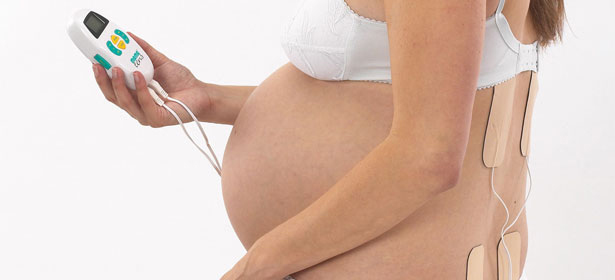
Pros of TENS Machine
- A TENS machine doesn’t affect your baby.
- You can stay in control of it yourself.
- You can use other pain relief at the same time.
- You can use it wherever you’re planning to give birth.
Cons of TENS Machine
- If you wait and start using a TENS machine when you’re in active labour, it will not be as effective.
- It may not work for all women.
- You can’t use it in a birthing pool, bath or shower as there is a danger of electrocution.

Water for Labour and Birth (Birthing Pool)
Some women find that being in the water helps them to relax and cope better . The water also provides support for your body so you can move more freely. A birth pool is larger and deeper than a bath so there is space to move in the water. You can hire or purchase a birth pool to use at home or they are available in all of our midwifery led units. There may some reasons why you might be advised not to have a water birth, such as complications in your pregnancy, your midwife or obstetrician will discuss these with you.
Evidence supports the use of water and has found that it can reduce the length of the first stage of labour and reduce the need for epidural analgesia. There is no evidence of increased adverse risks or outcomes to the baby or mother. Research is limited as there have been no large, collaborative, randomised controlled trials to date. A major national survey reported no increase in the incidence of adverse outcome for mother and baby following the use of water for women in spontaneous labour and following an uncomplicated pregnancy.
Pros of Birthing Pool
- The water allows you to experience a ‘weightless’ feeling and can reduce both your body’s production of stress related hormones and increase the body’s own pain relieving hormones.
- You stay in control of it because you can get out at any time.
- You can also use gas and air (Entonox).
- Water can help the tissues of the perineum to stretch and relax. This is known to reduce the chance of having severe tears or the need for an episiotomy.
Cons of Birthing Pool
- Pain relief options are limited as you are not able to continue use a TENS machine or have a morphine injection or epidural.
- The birth pool may not be available if it is already in use.
- Birth pools take time to fill, so if things happen quickly you might not have time to use it.
Gas and Air (Entonox)
Gas and Air is a mixture of oxygen and nitrous oxide gas. It will not remove all of the intensity from the contraction but it can help reduce it and make it more manageable.
You breathe it in just as a contraction begins using a mouthpiece, which you hold yourself. It works best if you take slow, deep breaths. Many women like it because it’s easy to use and they control it themselves. It takes about 15-20 seconds to work, so you breathe it in just as a contraction begins.

Pros of Gas and Air
- It takes the edge off the contraction and is easy to use.
- It works quickly.
- It can be used at any time during labour.
- It can be used with other forms of pain relief.
- You are in control of how often and when to use it.
- There are no effects to the baby.
- You can stop using it at any point and the effects go away quickly.
Cons of Gas and Air
- The pain relief effect can be mild .
- It might make your mouth feel dry (sipping water or sucking ice cubes will help with this).
- It may make you feel sick or lightheaded, if this happens you can stop using it and the effects will ease.
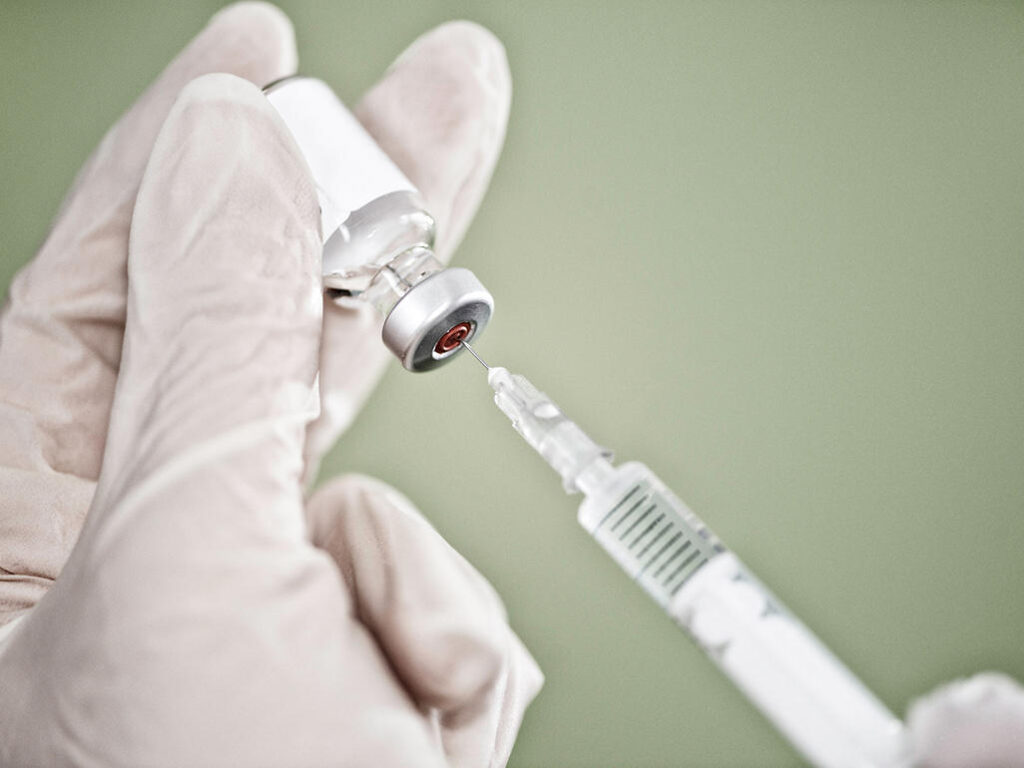
Morphine Injection
Morphine is an opioid drugs. These are strong painkillers. Morphine is given as an injection into a big muscle, such as your buttock or the top of your leg. It takes around about 15 minutes to work and the effects tend to last for around 2 and 4 hours.
Morphine can affect your baby’s breathing when they are born, particularly if it’s given shortly before you give birth. If you’re about to give birth your midwife or doctor may suggest you don’t have them for this reason and will try to offer you alternatives.
Pros of Morphine Injection
- Morphine and opioid drugs work quickly and last for a few hours.
- They may help you cope better with contractions.
- You may be able to sleep through contractions.
- They can help you to relax.
Cons of Morphine Injection
- It can cause nausea and vomiting, anti-sickness medication is therefore usually given at the same time to help with this.
- It can make you feel sleepy and not in control.
- It crosses the placenta and may affect you baby’s breathing after the birth and they may be drowsy. Which could affect breastfeeding.
- You won’t be able to use the birthing pool for at least 2 hours after you’ve had an injection.
Remifentanil
Remifentanil is a opioid drugs which is a strong painkiller similar to morphine, however it is very short acting. It is given by a pump connected to a drip in your hand or your arm. You control the medication yourself with a button, this is called patient-controlled analgesia (PCA). You press the button when you feel a contraction building. The machine has a safety mechanism which means you can only give yourself one dose every few minutes. Because you’ll be attached to monitors and a drip, you may not be able to move around as freely.
You can only have Remifentanil if you are in Labour ward at Aberdeen Maternity Hospital.
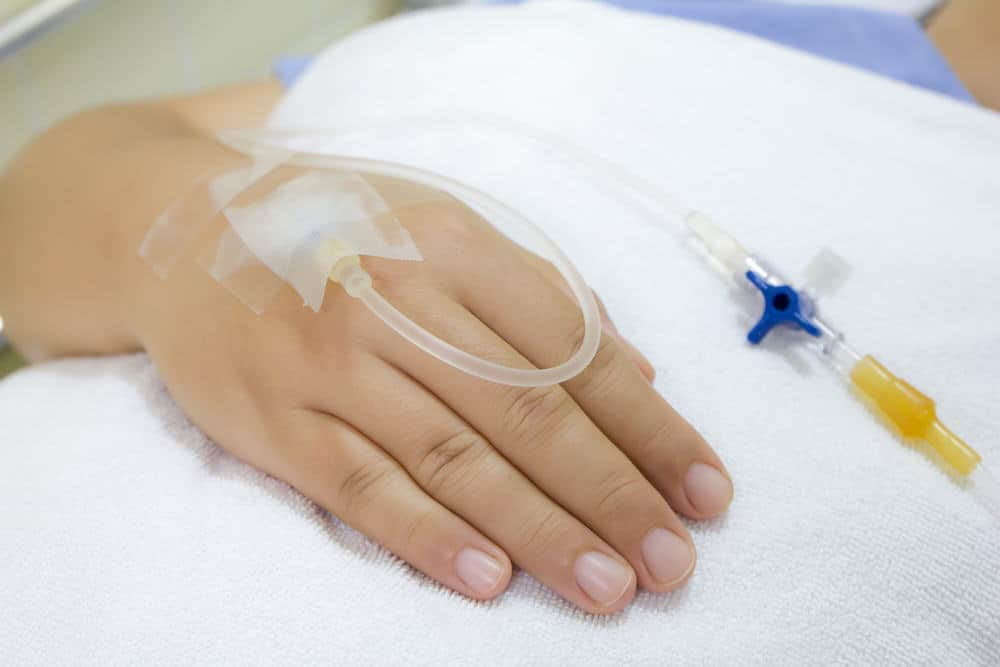
Pros of Remifentanil
- It works quickly- you will usually feel effects happen within 20-30 seconds of pressing the button.
- It is removed by the body quickly, so it has few side-effects for you and your baby.
- As it is removed from the body quickly the side-effects are usually short lived and gone within around 15 minutes.
- You are in control of your pain relief.
Cons of Remifentanil
- It can make you feel sleepy.
- It does not provide total pain relief.
- It can cause sickness and itching.
- You may experience some periods of memory loss.
- You will need some extra monitoring as it can slow down your breathing and lower your oxygen levels, this will be monitored using a small clip on one of your fingers. Your midwife will observe this closely and you may need a small amount of oxygen.

Epidural
An epidural is a small tube inserted into your back to deliver pain-relieving medicine. It numbs the nerves that carry the pain impulses from the birth canal to the brain. The aim of an epidural is to ease the pain of labour while still letting you, move around the bed and push when your baby’s being born.
If you choose to have an epidural, you and your baby will need to be monitored more closely. Your blood pressure will be checked more often, and you will be put on a fluid drip. Your baby’s heartbeat will also need to be monitored using a CTG machine (electronic monitoring). An epidural should continue until after your baby is born, your placenta is delivered and any stitching you need has been done.
An anaesthetist is the only person who can give an epidural, therefore you can only have an epidural if you are in Labour ward at Aberdeen Maternity Hospital.
You can find out more about an epidural including the benefits and potential risks by clicking the link below.
Pros of an Epidural
- It usually provides good pain relief.
- It takes away the sensation of the of contractions and may take away the sensation of giving birth too.
- Can be topped up for a caesarean section if required.
- It is not linked to a longer first stage of labour or an increased chance of having a caesarean section.
- It doesn’t make you sleepy.
- In general epidurals do not affect your baby and you can breastfeed as normal when they are born.
Cons of an Epidural
- You may not be able to move around as much after you’ve had a few top-ups.
- About 1 in 10 epidurals don’t work perfectly at first. If yours doesn’t work, you may need to have it adjusted or replaced.
- It can cause bad headaches for a few days or weeks after the birth in about 1 in 100 cases – this can usually be treated with painkillers and fluids but sometimes needs special treatment.
- It can cause a long-lasting nerve injury, such as a numb patch on your leg or a slightly weak leg.
- Epidurals are linked to a longer second stage of labour (pushing stage) and an increased chance of an assisted vaginal birth (Ventouse or Forceps)
- You will need to be monitored more closely in labour.
- You may develop low blood pressure, itching or a fever during the epidural.
- The epidural site may be tender but usually only for a few days. Backache is NOT caused by epidurals but is common after any pregnancy.
Pain relief options comparison
The below picture highlights the pain relief options available across Grampian. For more information regarding each of these locations and your options around where you can choose to have your baby in Grampian. please click on the below link.
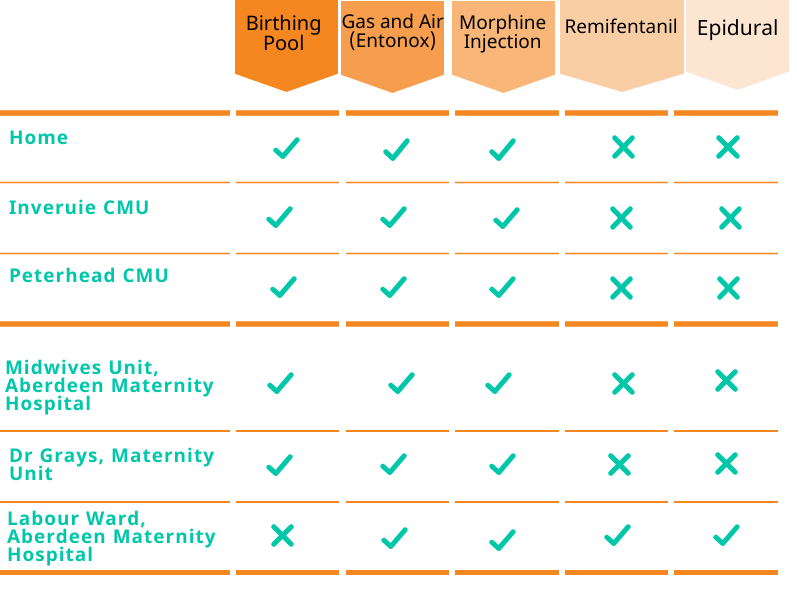
The Labour Pains website has some useful information and resources available exploring the different pain relief options available. Below is a chart created by them which highlights and compares some of the different pain relief options available to you. There are also several translations available for their leaflets and resources which you can access by clicking the below link,
pain-relief-comparison-card-september-2014